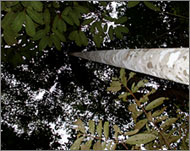Amazon made safer by satellite
Seven thousand square kilometres of the Amazon rain forest have been saved from illegal logging and burning thanks to satellite surveillance, the Brazilian government has said.

According to the Brazilian Environmental Protection agency, Satellite monitoring has proven to be a valuable tool in detecting deforestation activities within protected areas of the forest.
Brazilian Environment Minister Marina Silva said it has 15 manned stations to alert them of illegal deforestation.
Silva also told reporters that the vigilance of Amazon communities helped curb illegal logging and burning of the verdant forest to clear land for farming and ranching.
Still, environmentalists fear this year’s toll from deforestation will be as high or higher than last year’s total of 25,500 square kilometres because of increasing pressure from farming, logging and mining interests.
That marked a 40% jump on the previous year.
Farmers blamed
Most of the deforestation is caused by farmers burning the jungle to create cattle ranches and soy farms.
Silva said between 15 and 18% of the Amazon, which covers an area about half the size of the continental United States, had already been destroyed. The government is seeking to preserve much of the remaining land.
 |
|
Critics say that deforestation still |
“It’s a very worrying situation. We are seeking an integrated solution,” Silva said.
The new government of President Luiz Inacio Lula da Silva has been criticised by environmentalists for having no clear policy to prevent deforestation of the Amazon, also threatened by huge road, hydro-electric dam and gas pipeline projects.
Long-term plan
Silva said a group of 12 government ministries was drawing up a long-term plan to protect the forest, home to 30% of the planet’s animal and plant species and an important source of medicines.
Silva said the involvement of some 3,000 local communities was key because they depend on the forest for their livelihoods and would ultimately be among its fiercest guardians.
Sustainable policies for exploiting the forest’s timber and agricultural resources are also important, she said.
“We need new rules to help local communities exploit mahogany in a sustainable way,” Silva said, noting that only 5% of the Amazon’s timber was logged legally.